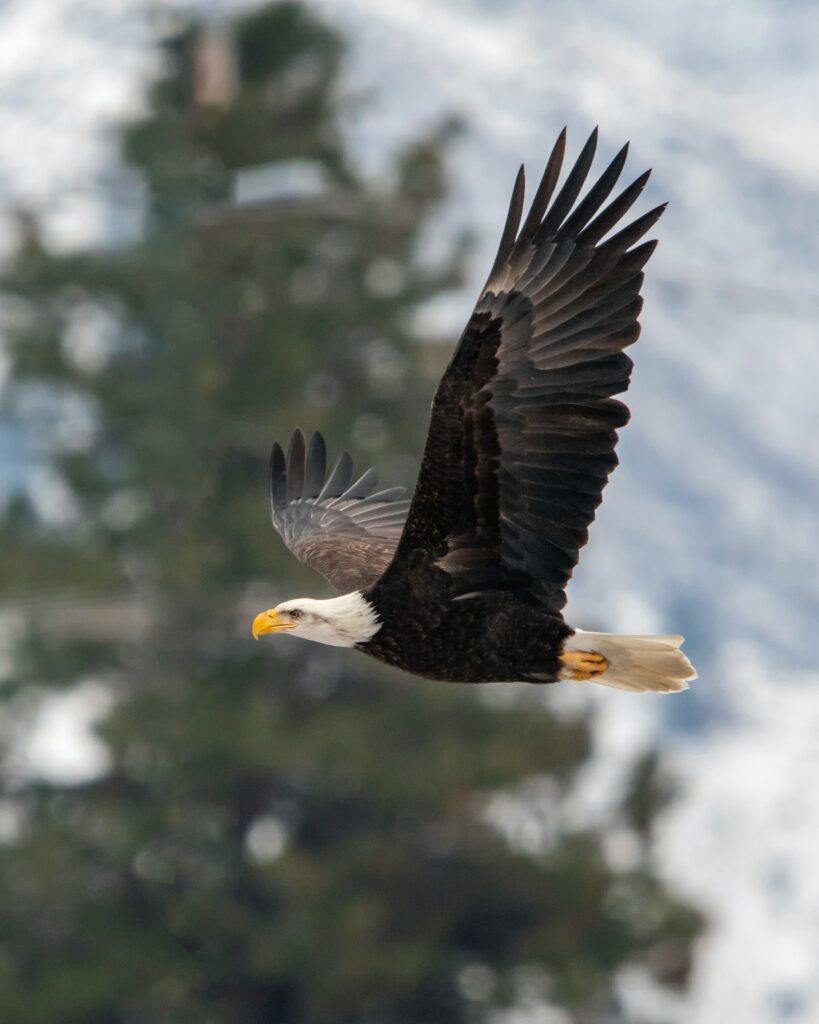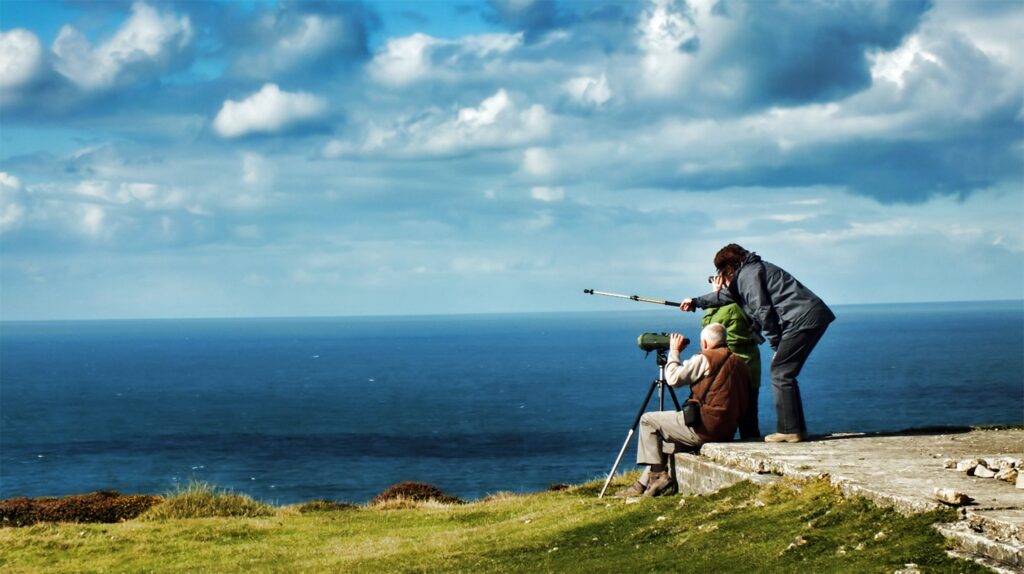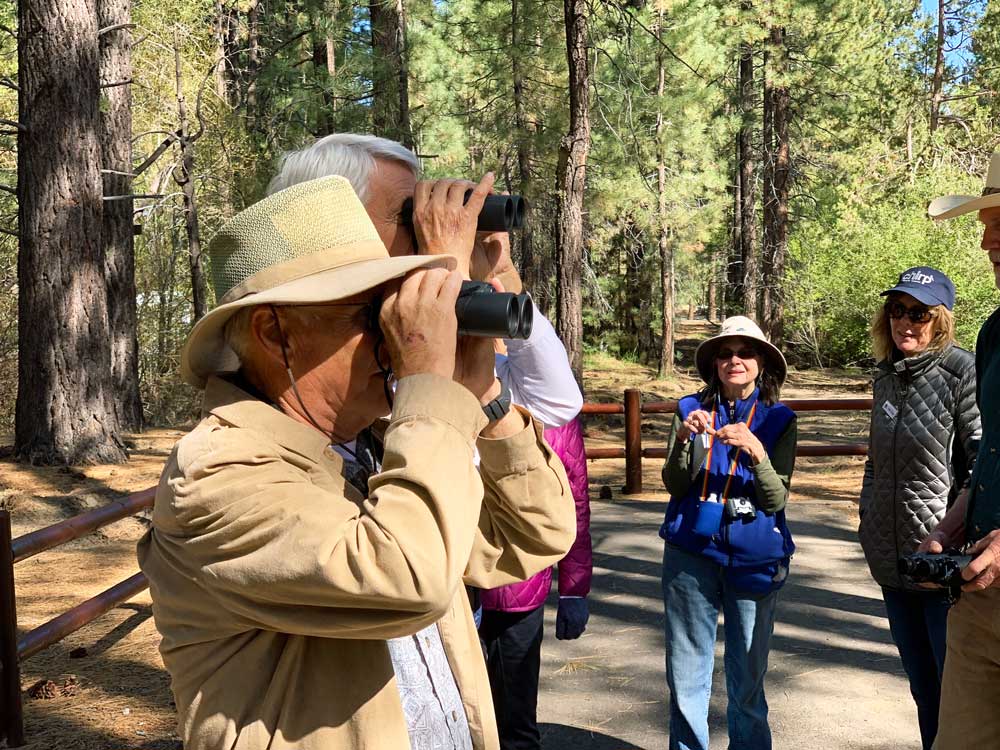Ready for some next-level birdwatching? These advanced birder challenges are the perfect way to take it up a notch. Whether you’re an experienced birdwatcher seeking to hone your skills or simply make things more interesting, we’ve got the challenge for you.
Find These Rare Birds in Big Bear

Every experienced birder has that “one that got away.” Usually, it’s more than one: it’s several rare birds they’d love to sight. If you fit into this category, we challenge you to find these rare birds in the Big Bear Valley. (We’ve also included notes on where and when to find some of them.):
| Rare bird | Where to find them | Notes |
| Allen’s Hummingbird | Anywhere in the Big Bear Valley | Attract them to your backyard with hummingbird feeders |
| American Dipper | Along the Santa Ana River | Usually found around moving streams |
| Anna’s Hummingbird | Happy Hills Trail | Frequents hummingbird feeders |
| Bald Eagle | Big Bear Lake | Big Bear is home to two nesting Bald Eagles, Jackie and Shadow |
| Black-Chinned Hummingbird | East side of Big Bear Valley | Look for them in summer months; you can also find them at your hummingbird feeders |
| Calliope Hummingbird | Bluff Lake | A tough find; search during summer months; can sometimes be found at hummingbird feeders |
| Clark’s Nutcracker | Onyx Summit, Green Canyon, Fox Farm | Exclusively in coniferous forests; often found in flocks |
| Evening Grosbeak | Backyard bird feeders | Late September/October only |
| Gray Vireo | Smarts Ranch Road | Warm months only; look for them in willow trees |
| Harrier | Von’s Marsh | Search along the shoreline of Big Bear Lake |
| Hepatic Tanager | Smarts Ranch Road | Search during summer months |
| Lazuli Bunting | Coxie Meadow | Present from summer to early fall |
| Mountain Quail | Happy Hills Trail, Bluff Lake, Metcalf Meadow, Green Canyon | Look for them in open forest |
| Oak Titmouse | Backyard bird feeders | Attract them with sunflower seeds |
| Pinyon Jay | East side of Big Bear Valley | Very social; look for large flocks in open pine forests |
| Rufous Hummingbird | Anywhere in the Big Bear Valley | Spotted during migration in March; bring them to your yard with hummingbird feeders |
| White-Faced Ibis | Von’s Marsh; | Search along shoreline on Big Bear Lake |
| White-Headed Woodpecker | Bluff Lake | Listen for sharp “peek” sounds rapidly repeated in doubles or triples |
| Williamson’s Sapsucker | Bluff Lake | Occurs singly or in pairs |
Want more details on Big Bear’s best birding areas? Check out our “Where to Go Bird Watching in Big Bear Lake” guide.
Make a Life List

Maybe this is redundant to you, but if you haven’t started a life list, now’s the time to start! For those that don’t know, a life list is a list of wild birds one has seen and positively identified. Some birders keep these lists, adding to them throughout their life, just for their own record, while others submit their lists to organizations that help track bird activity.
When you consider there are at least 10,000 bird species in the world (some scientists say it’s closer to 20,000), and over 1,000 in the US alone, keeping a life list is quite a challenge. It’s also one you can continue your entire lifetime.
What tools do you need to make a life list? Of course, you could use a birding journal or an Excel spreadsheet to keep track of your bird sightings. But there are also several helpful online tools and apps. Here are some of our favorites:
- eBird (make sure to tag Chirp in your checklists!)
- Merlin
- Bird Guide
- Bird Journal
Try Birding by Ear

Even the National Audubon Society acknowledges that birding by ear is hard, which is why we’ve included it as a challenge! Make it a personal goal to identify birds by song and vocalizations alone, even identifying different birds in the same species. Luckily, there are plenty of apps out there to help you, such as:
Take a Birding Course

Feel like you’ve learned everything there is about birding? The wonderful thing about this hobby is that there’s always room to grow, both in knowledge and hands-on experience. If you feel stuck in a birding rut, consider taking an advanced birding course to get your head back in the game. Here are some reputable organizations that offer courses, both online and in-person:
- Bird Academy, by The Cornell Lab of Ornithology
- National Audubon Society’s local chapters often offer birding courses
- BirdWatching’s eWorkshops (included with membership)
- Chirp Nature Center’s Bird Talks (with bird experts as special guest speakers)
Enter a Birding Competition

Go it alone or pair up in teams for a fun birding competition. The most popular birdwatching contest is New Jersey Audubon’s World Series of Birding, which happens once a year, for one full day of competitive birding, where birders the world over compete to see how many different bird species they can see in 24 hours. Though a competition, it’s meant to be fun, and the proceeds go to the New Jersey Audubon to fund their conservation efforts.
The American Birding Association’s Big Year competition gives participants a full calendar year to spot and note as many wild bird species as they can within a certain area.
The Great Texas Birding Classic, organized by the Texas Parks and Wildlife Department, is another noteworthy birdwatching tournament. Birders come from all around the world to Texas’s birding hotspots. This tournament occurs once a year, typically in spring. Birdwatching teams compete to see which one can spot the most bird species in a given time period.
Of course, you can always join an Audubon Birdathon close to where you live. These events, hosted by the National Audubon Society, are mostly online events where you can compete individually or with a team to sight as many species in a single day.
Go on a Birding Trip

Perhaps all you need is a change of scenery. A birding trip to one of the nation’s or world’s birding meccas might be just the thing. Of course, the Big Bear Valley is considered a top birdwatching destination, with over 250 bird species (many of them rare). Here are a few other places to consider.
US birding hotspots:
- Everglades National Park, Florida
- Cape May, New Jersey
- Prospect Park, New York
- Kōke’e State Park, Hawaii
- Lucy Peak State Park, Idaho
- Point Reyes, California
- Big Bend National Park, Texas
- Grand Isle, Louisiana
- Mount Desert Island, Maine
Worldwide birding hotspots:
- Eastern Hokkaido, Japan
- North Queensland, Australia
- Kruger National Park, South Africa
- Monteverde, Costa Rica
- Varirata National Park, Papua New Guinea
- Rift Valley, Kenya
- Colca Canyon, Peru
- Norfolk, UK
- Wadden Islands, Denmark/Netherlands
Chirp Has Something for Everyone

Young or old, novice or experienced, we welcome birdwatchers one and all at Chirp! Join fellow naturalists at one of our free events. We offer guided bird walks once a month around the Big Bear Valley, and special bird talks given by bird experts. Periodically, we also offer special events like bird cruises—it’s all on our Activities page!
Got an expert birding tip to share with Chirp readers? We’d love to hear it! Leave it in the comments below!
Before you start your birding challenge, pick up a copy of our free “Birdwatching Guide for Big Bear Lake” from the Chirp Nature Center. It includes a map of the Big Bear area and a list of the birds you’ll likely run into, as well as other tips for new, young, and advanced birders. Happy Birding!


